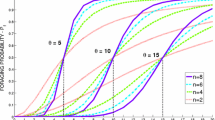Abstract
Swarm robotics is a branch of collective robotics systems that offers a set of remarkable advantages over other systems. The global behavior of swarm systems emerges from the local rules implemented at the individual level. Therefore, characterizing a global performance obtained at the swarm level is one of the main challenges, especially under complex dynamics such as spatial interferences. In this paper, we exploit the central limit theorem to analyze and characterize the swarm performance over long-term deadlines. The developed model is verified on two tasks: a foraging task and an object filtering task.
























Similar content being viewed by others
Notes
The central limit theorem, in its classic version, states that the mean of a sufficiently large set of independent and identically distributed random variables each with a finite mean and variance tends to be distributed normally (Rice 2001).
ARGoS is a discrete-time physics-based simulation framework developed within the Swarmanoid project. It can simulate various robots at different levels of details, as well as a large set of sensors and actuators.
References
Campo A, Dorigo M (2007) Efficient multi-foraging in swarm robotics. In: Advances in artificial life, proceedings of ECAL 2007, vol LNAI 4648. Springer, Berlin, pp 696–705
Dunsmuir W (1979) A central limit theorem for parameter estimation in stationary vector time series and its application to models for a signal observed with noise. Ann Stat 490–506 (1979)
Goldberg D (2001) Evaluating the dynamics of agent-environment interaction. Ph.D. thesis, University of Southern California
Goldberg D, Matarić M (2000) Reward maximization in a non-stationary mobile robot environment. In: Proceedings of the fourth international conference on Autonomous agents. AGENTS ’00ACM, New York, pp 92–99
Jacod J, Podolskij M, Vetter M (2010) Limit theorems for moving averages of discretized processes plus noise. Ann Stat 38(3):1478–1545
Jarque C, Bera A (1980) Efficient tests for normality, homoscedasticity and serial independence of regression residuals. Econ Lett 6(3):255–259
Khaluf Y, Birattari M, Rammig F (2013) Probabilistic analysis of long-term swarm performance under spatial interferences. In: Theory and practice of natural computing. 2nd international conference on the theory and practice of natural computing, TPNC 2013. Springer, Cáceres (2013)
Labella T, Dorigo M, Deneubourg J (2006) Division of labour in a group of robots inspired by ants’ foraging behaviour. ACM Trans Autonom Adapt Syst 1(1):4–25
Lein A, Vaughan R (2008) Adaptive multirobot bucket brigade foraging. In: Proceedings of the eleventh international conference on artificial life, ALife XI. MIT Press, New York, pp 337–342
Lerman K, Galstyan A (2002) Mathematical model of foraging in a group of robots: effect of interference. Autonom Robots 13(2):127–141
Lerman K, Martinoli A, Galstyan A (2005) A review of probabilistic macroscopic models for swarm robotic systems. In: Sahin E, Spears W (eds) Swarm robotics. Lecture notes in computer science, vol 3342, chap 12. Springer, Berlin, pp 143–152 (2005)
Liu W, Winfield A, Sa J (2007) Modelling swarm robotic systems: a case study in collective foraging. In: Towards autonomous robotic systems (TAROS 07), Aberystwyth, pp 25–32
Martinoli A, Kjerstin E, William A (2004) Modeling swarm robotic systems: a case study in collaborative distributed manipulation. Int J Robot Res 23:415–436
Muniganti P, Pujol A (2010) A survey on mathematical models of swarm robotics. In: Workshop of physical agents
Ostergaard E, Sukhatme G, Matari M (2001) Emergent bucket brigading: a simple mechanisms for improving performance in multi-robot constrained-space foraging tasks. In: Proceedings of the fifth international conference on autonomous agents. AGENTS ’01ACM, New York, pp 29–30
Pinciroli C, Trianni V, O’Grady R, Pini G, Brutschy A, Brambilla M, Mathews N, Ferrante E, Caro G, Ducatelle F, Birattari M, Gambardella L, Dorigo M (2012) Argos: a modular, parallel, multi-engine simulator for multi-robot systems. Swarm Intell 6:271–295
Pini G, Brutschy A, Birattari M, Dorigo M (2009) Interference reduction through task partitioning in a robotic swarm. In: Filipe J, Andrade-Cetto J, Ferrier JL (eds) Sixth international conference on informatics in control, automation and robotics—ICINCO 2009. INSTICC Press, Setúbal, pp 52–59
Pini G, Brutschy A, Birattari M, Dorigo M (2011) Task partitioning in swarms of robots: reducing performance losses due to interference at shared resources. In: Cetto J, Filipe J, Ferrier J (eds) Informatics in control automation and robotics. Lecture notes in electrical engineering, vol 85. Springer, Berlin, pp 217–228
Rice J (2001) Mathematical statistics and data analysis, 3 edn. Duxbury Press, Pacific Grove (2001)
Shah R, Roy S, Jain S, Brunette W (2003) Data mules: modeling and analysis of a three-tier architecture for sparse sensor networks. Ad Hoc Netw 1(2):215–233
Shell D, Mataric M (2006) On foraging strategies for large-scale multi-robot systems. In: 2006 IEEE/RSJ international conference on intelligent robots and systems. IEEE, New York, pp 2717–2723
Vardy A (2012) Accelerated patch sorting by a robotic swarm. In: 2012 ninth conference on computer and robot vision (CRV), pp 314–321
Vaughan A (2008) Adaptive multi-robot bucket brigade foraging. Artif Life 11:337
Author information
Authors and Affiliations
Corresponding author
Ethics declarations
Conflict of interest
The authors declare that they have no conflict of interest.
Additional information
Communicated by C. M. Vide.
Rights and permissions
About this article
Cite this article
Khaluf, Y., Birattari, M. & Rammig, F. Analysis of long-term swarm performance based on short-term experiments. Soft Comput 20, 37–48 (2016). https://doi.org/10.1007/s00500-015-1958-0
Published:
Issue Date:
DOI: https://doi.org/10.1007/s00500-015-1958-0




